Introduction Kiwi Brand Stainless Steel 8-Inch Thai Chef’s Knife No. 21
A Budget-Friendly Kitchen Gem
Overview
Key Specifications
- Blade Length: 7.5–8 inches (total length ~12 inches)
- Blade Material: Stainless steel (unspecified alloy, soft steel)
- Blade Thickness: ~2mm, hollow grind
- Handle Material: Hardwood, double-riveted
- Weight: 130 grams (4.6 ounces)
- Overall Dimensions: ~12 inches long x 2.5 inches wide (blade)
- Features: Lightweight, stain-resistant, hand-wash only, rust-resistant
- Origin: Made in Thailand
Pros
1. Razor-Sharp Edge for Precision Cutting. The thin stainless steel blade arrives sharp, with users noting it “cuts through tomato skin like a sharp, new knife” despite a BESS sharpness score of ~410g out of the box, indicating an edge needing maintenance. The hollow grind and thin profile (2mm) make it feel sharper than it tests, excelling at slicing vegetables, fruits, and cooked meats with minimal resistance. Users praise its ability to produce “fine rings and slices” without crushing ingredients, ideal for stir-fries or fruit carving.
2. Lightweight and Maneuverable—At 130 grams, the Kiwi No. 21 is one of the lightest chef’s knives available, making it highly maneuverable for quick, repetitive tasks like dicing onions or chopping herbs. The blade-forward balance suits a pinch grip, which is comfortable for both beginners and experienced cooks. Customers describe it as “slicy and agile,” perfect for Asian-style cooking where precision and speed are key.
3. Exceptional Value for Money
5. Comfortable Wooden Handle—The double-riveted hardwood handle is lightweight and provides a secure, comfortable grip. Users appreciate its “natural feel” and “adequate weight” for quick dicing and chopping. The handle’s simplicity adds to the knife’s affordability without sacrificing usability, and its brass rivets ensure durability for light to moderate use.
6. Versatility for Asian Cooking—Designed for Thai, South East asian and East Asian cuisine, the Kiwi No. 21’s thin, curved blade excels at rock-chopping vegetables, herbs, and meats for dishes like stir-fries or Thai salads Its flexibility makes it suitable for delicate tasks like fruit carving, earning praise from professional fruit carvers. It’s a go-to knife in many Asian households, with one user stating, “Step into any Asian American home, and you’ll likely find a Kiwi Knife.”
7. Durable for Light-Duty Tasks—Despite its low cost, the Kiwi No. 21 is surprisingly durable for light-duty prep, with users reporting it lasts “months or even years” with proper care. The stainless steel blade resists rust, and the wooden handle holds up well with regular hand washing, making it a reliable tool for daily cooking.
Cons:
1. Soft Steel with Poor Edge Retention—The soft stainless steel dulls quickly, requiring frequent honing (daily for heavy use) or sharpening every few weeks. Users note, “A piece of paper can hold an edge longer than a Kiwi,” highlighting its need for regular maintenance. While easy to sharpen, this can be a hassle for cooks who prefer low-maintenance knives like the Victorinox Fibrox.
2. Not Suitable for Heavy-Duty Tasks—The thin, flexible blade (2mm) and half-tang construction make it unsuitable for heavy chopping or cutting through bones, hard squashes, or frozen foods. Users warn that the soft steel may bend or roll under stress, with one stating, “It’s not sturdy enough for hard foods.” For such tasks, a heavier cleaver or German-style knife is recommended.
3. Lightweight Design Lacks Power—At 130 grams, the knife lacks the heft needed for forceful chopping, such as mincing garlic or breaking down poultry. Users note, “It’s not heavy, so no real balance or power,” making it less versatile than heavier knives like the Wüsthof Classic.
4. Basic Fit and Finish—The half-tang construction and inexpensive materials give the knife a “cheap feel,” with some users noting it “feels like an $8 knife.” While the spine and choil are smooth enough for a comfortable pinch grip, the handle’s basic design and lack of full-tang durability may disappoint those seeking a premium aesthetic or build.
5. Not Dishwasher-Safe—The Kiwi No. 21 is hand-wash only, as the wooden handle can degrade in a dishwasher, and the soft steel may dull or develop nicks. Users recommend hand washing and immediate drying to maintain the blade and handle, adding a minor inconvenience compared to dishwasher-safe options like the Victorinox Fibrox.
Durability
The Kiwi No. 21 is durable for light-duty tasks like slicing vegetables, fruits, and cooked meats. The stainless steel blade resists rust with proper care, and users report blades lasting “years” with regular honing and sharpening. However, the soft steel is prone to dulling, and the half-tang construction is less robust than full-tang knives, making it unsuitable for heavy chopping or prolonged commercial use. The wooden handle is sturdy but requires hand washing to prevent cracking or warping. With proper care, the knife offers surprising longevity for its price, though it’s not built for the rigors of professional kitchens like the Victorinox Fibrox or Dexter knives.
Handling and Care Tips
To maximize the Kiwi No. 21’s performance and longevity:
- Grip: Use a pinch grip for precision slicing or a hammer grip for light chopping. The lightweight handle supports both comfortably.
- Cutting Technique: Leverage the curved blade for rock-chopping vegetables or herbs. Avoid hard foods like bones or frozen items to prevent bending.
- Cutting Surface: Use a wooden or plastic cutting board to preserve the edge. Avoid glass or stone surfaces, which can dull the blade.
- Cleaning: Hand wash with mild soap and warm water, drying immediately to protect the wooden handle and prevent rust. Avoid dishwashers.
- Sharpening: Hone daily with a ceramic rod or honing steel to maintain the edge. Sharpen every 2–4 weeks on a 1000/3000-grit whetstone or use an inexpensive pull-through sharpener for ease.
- Storage: Store in a knife block, magnetic strip, or sheath to protect the blade. Avoid loose drawer storage to prevent nicks.
- Avoid Misuse: Do not use on bones, hard squashes, or non-food items, as the thin blade may bend or roll.



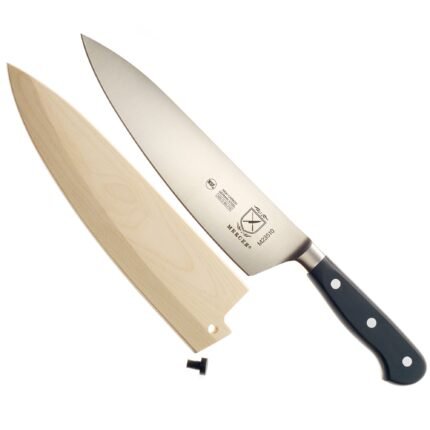
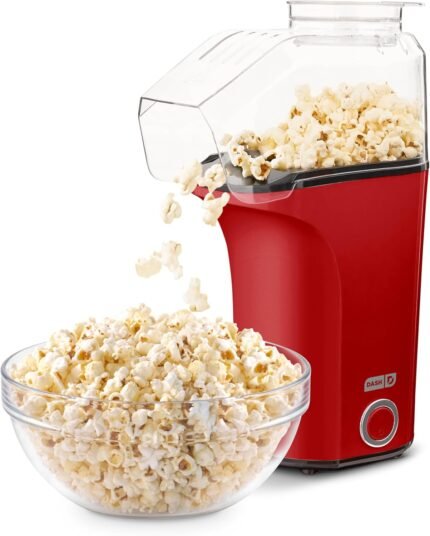
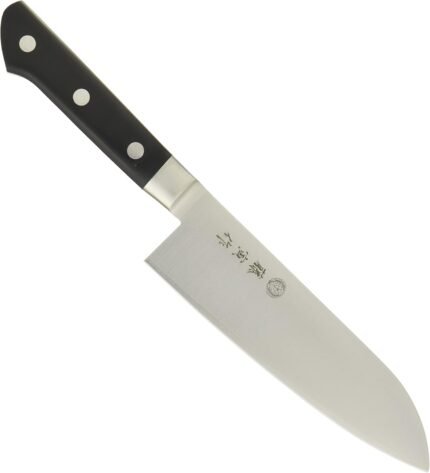
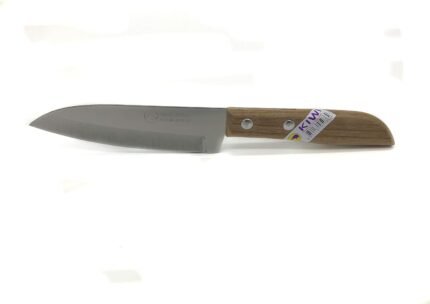

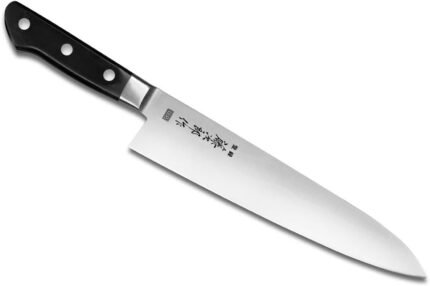
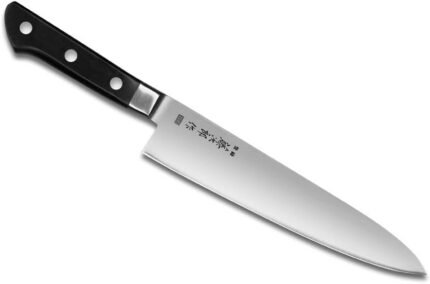
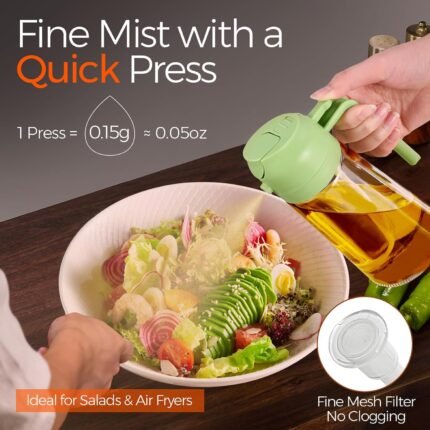
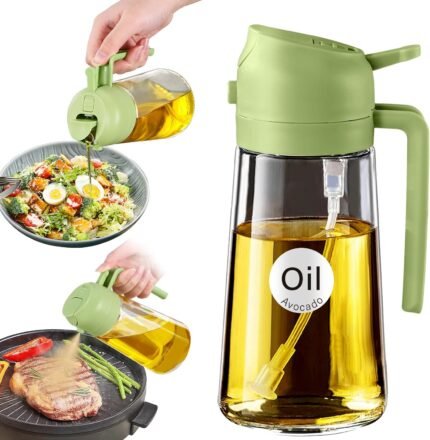
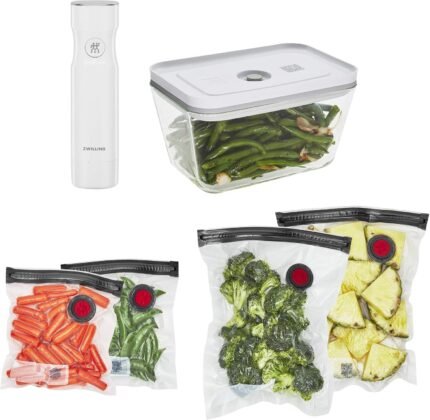
Reviews
There are no reviews yet.